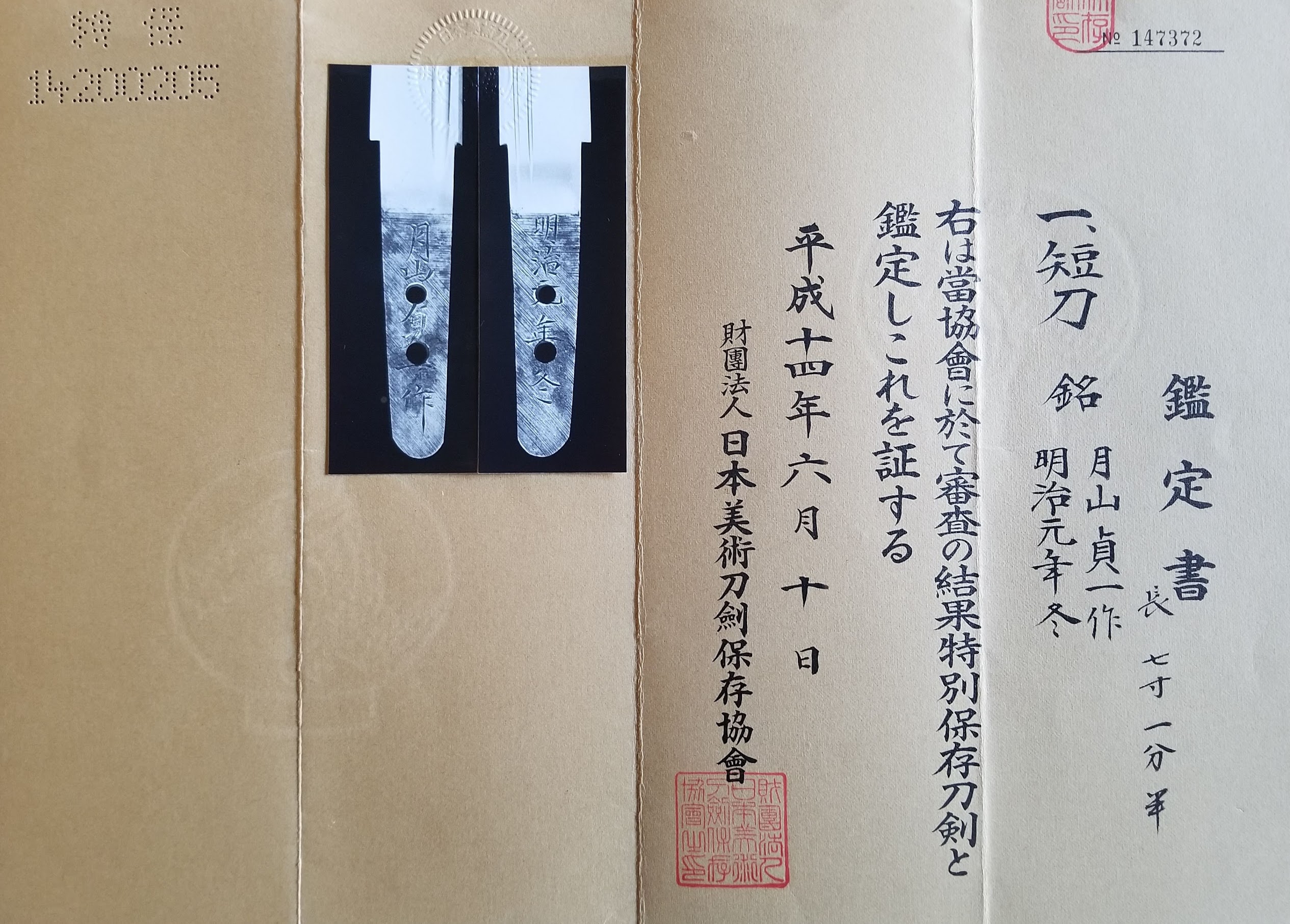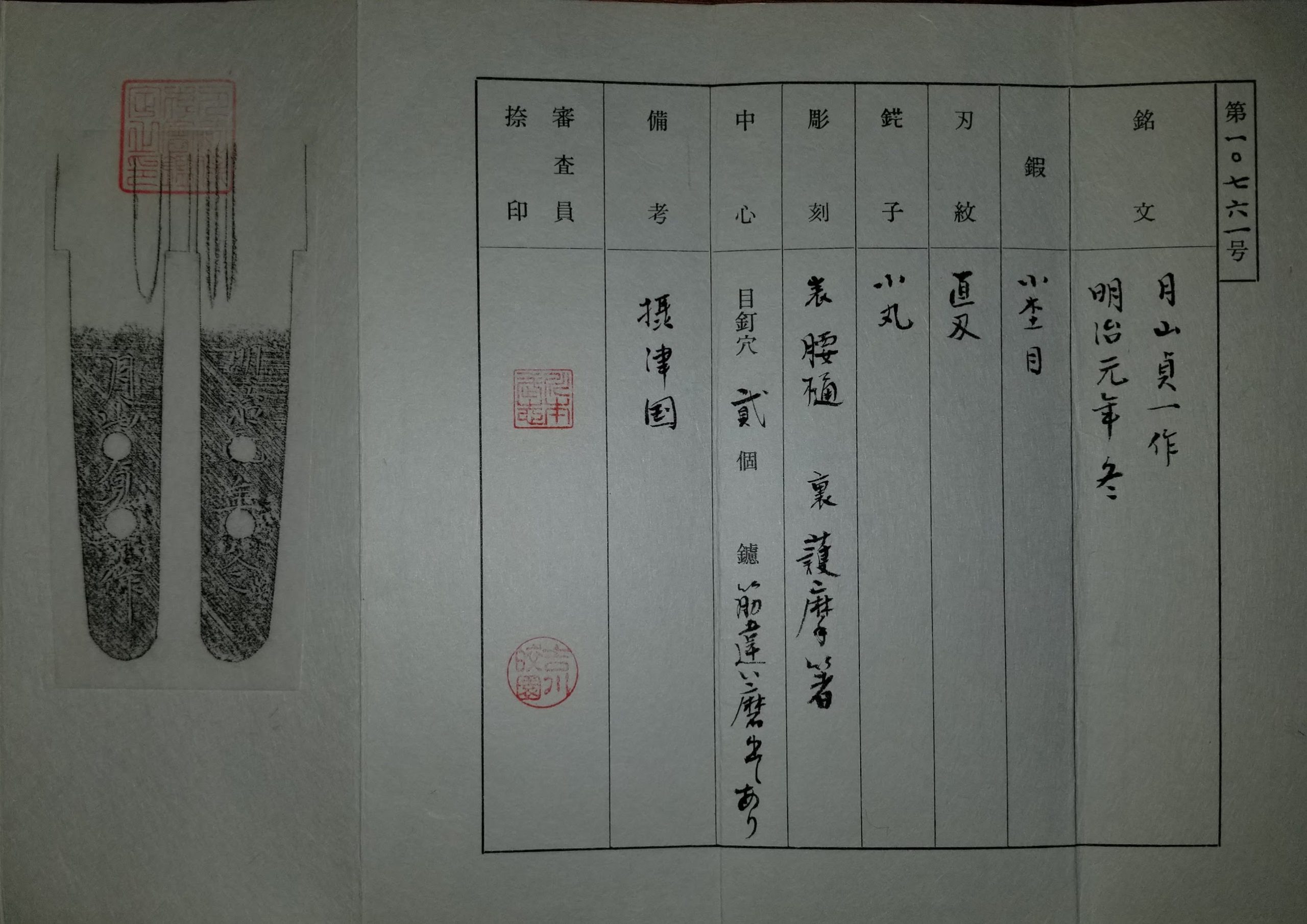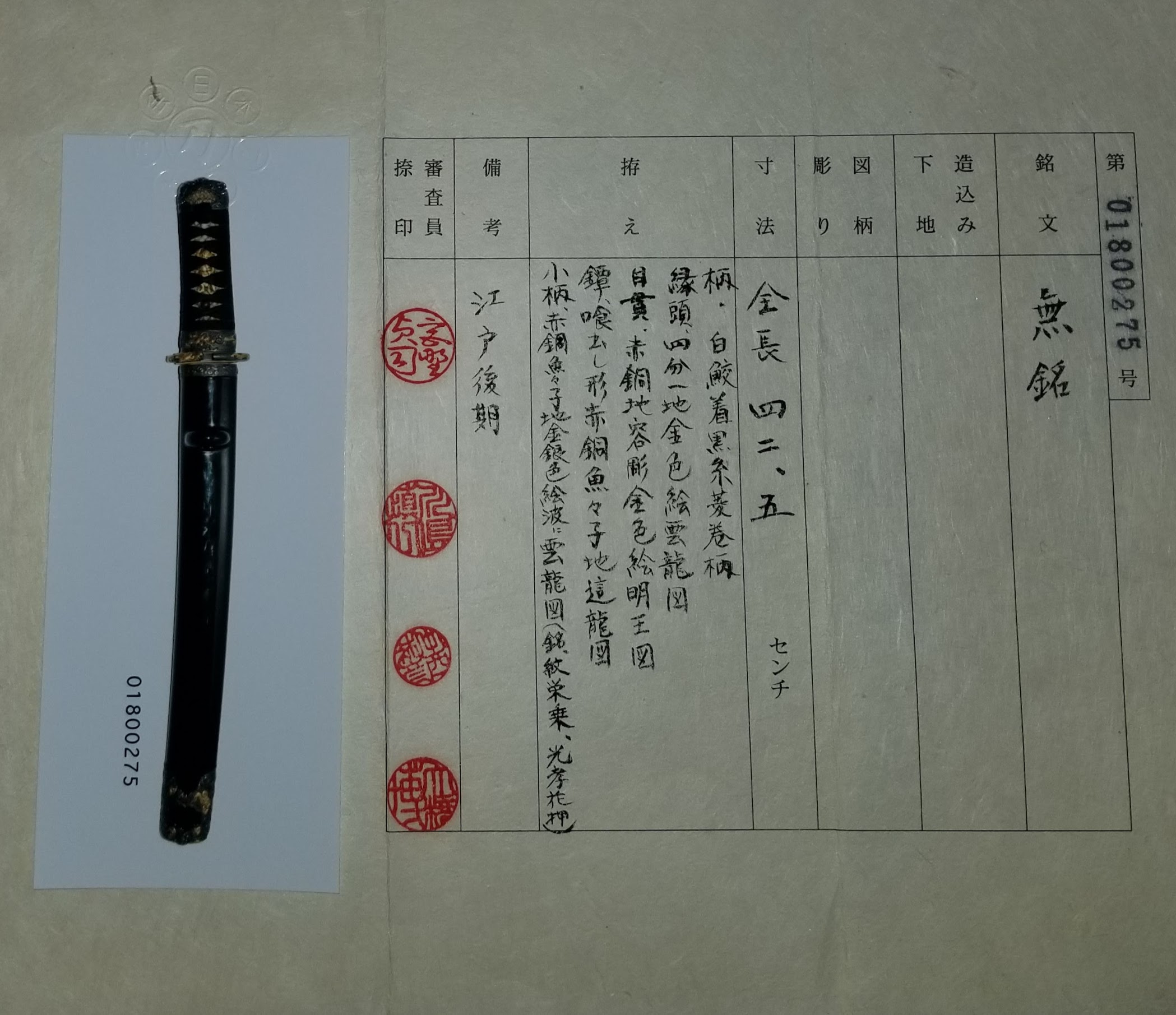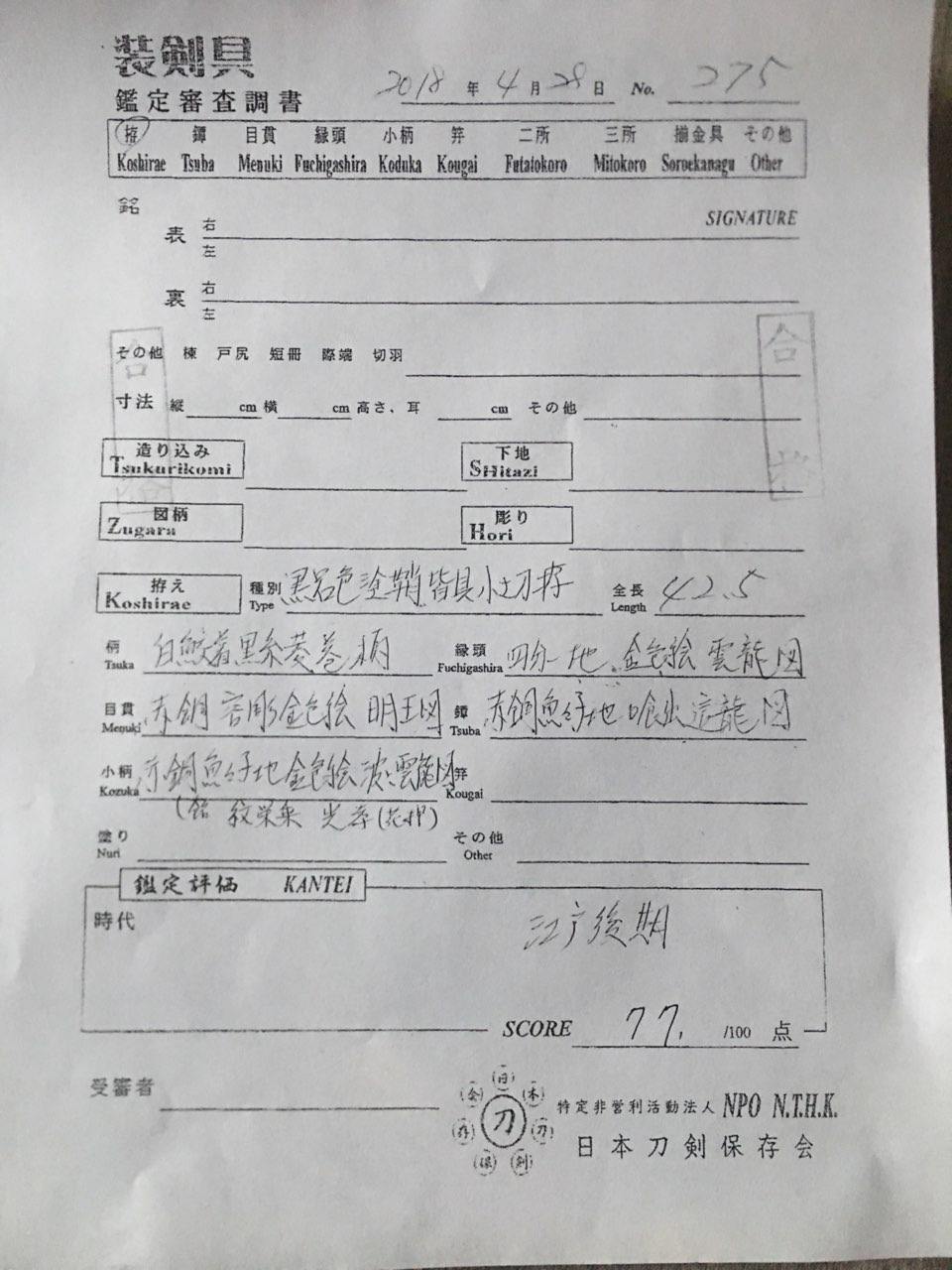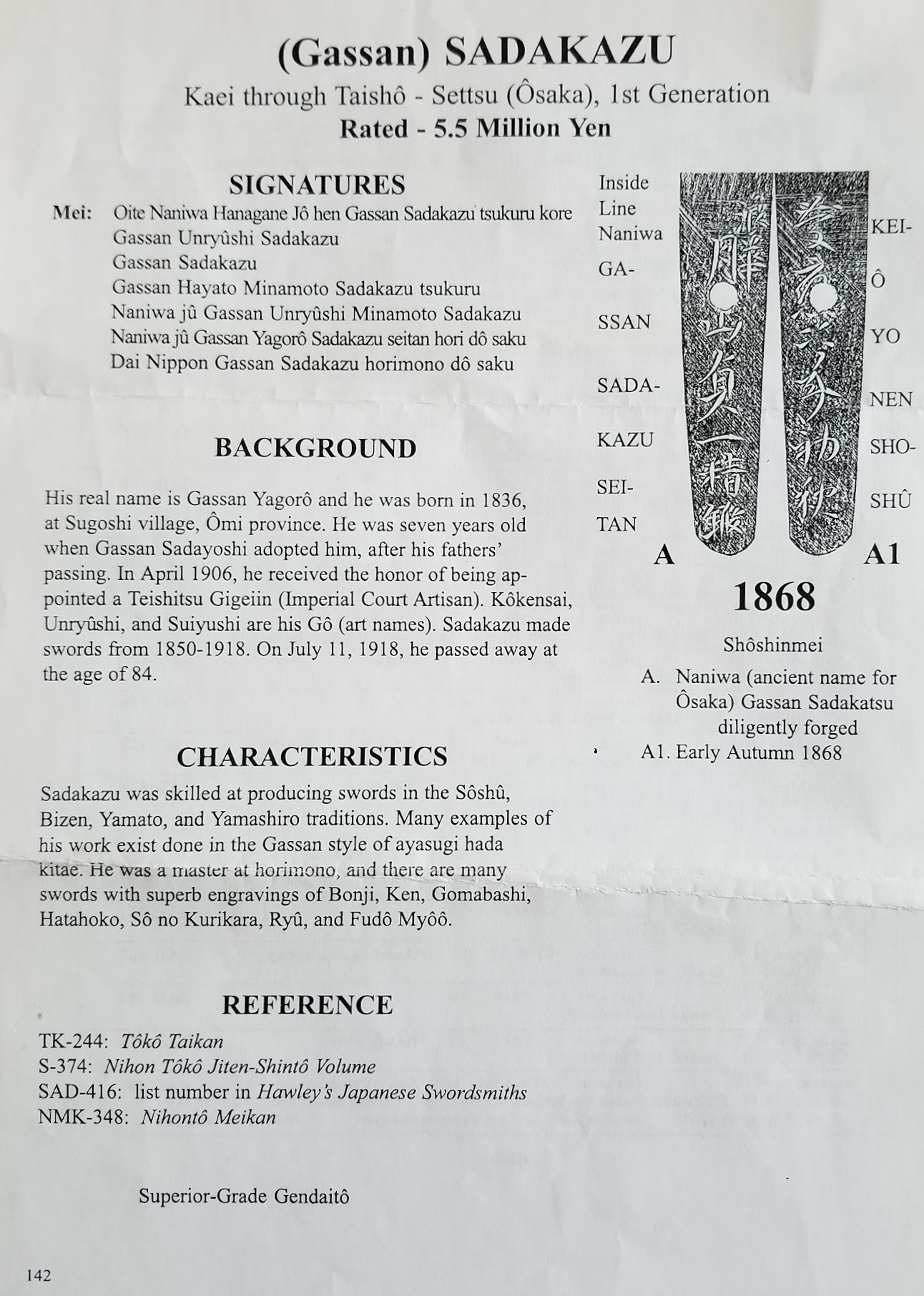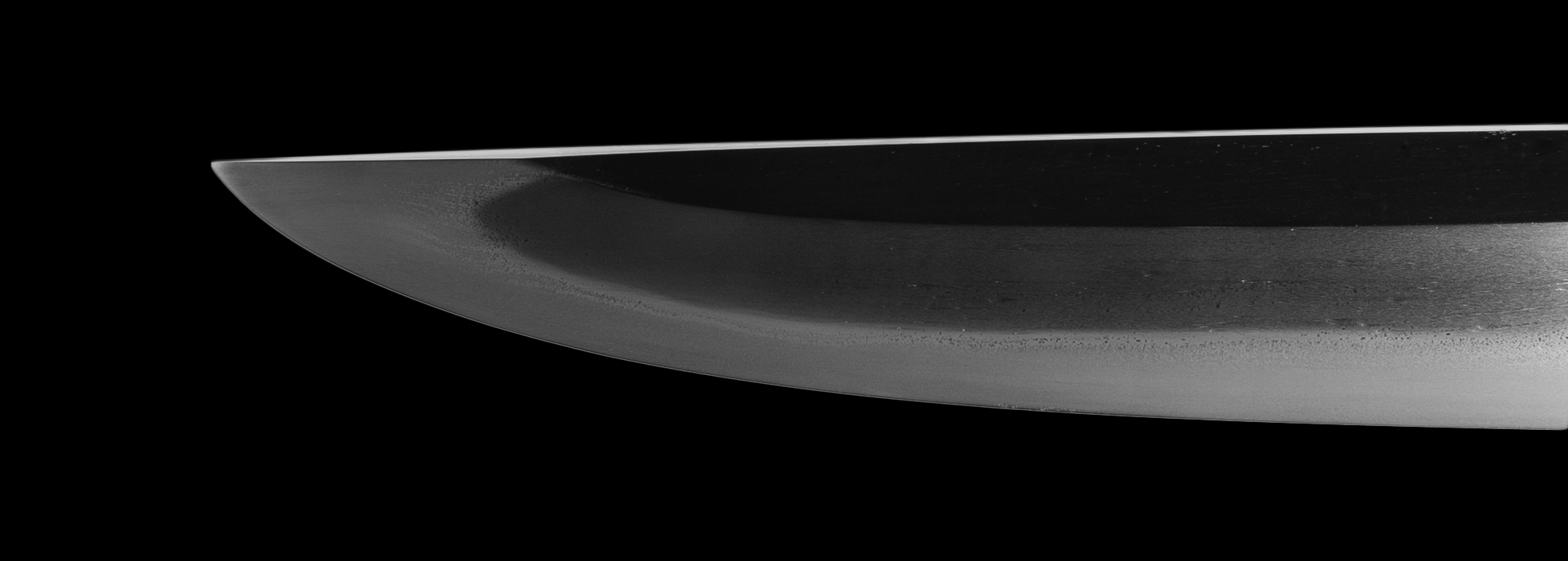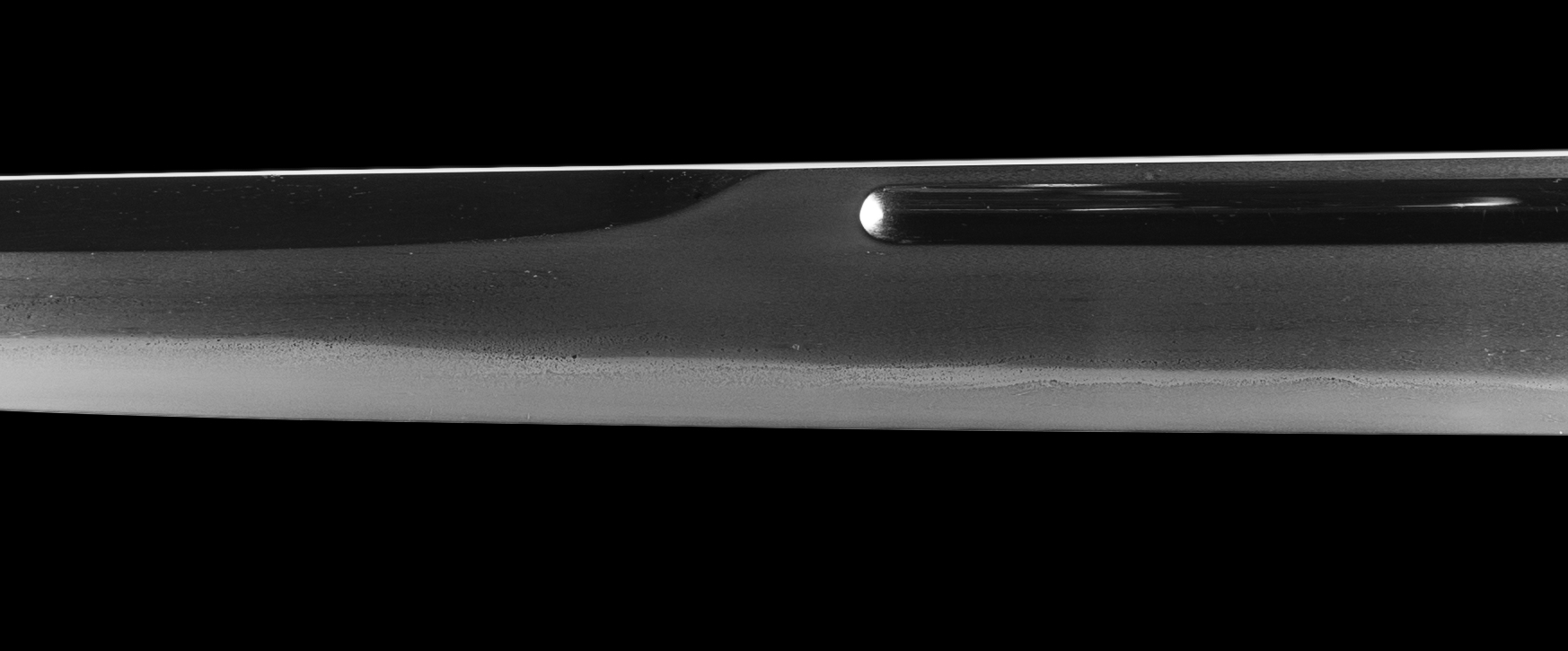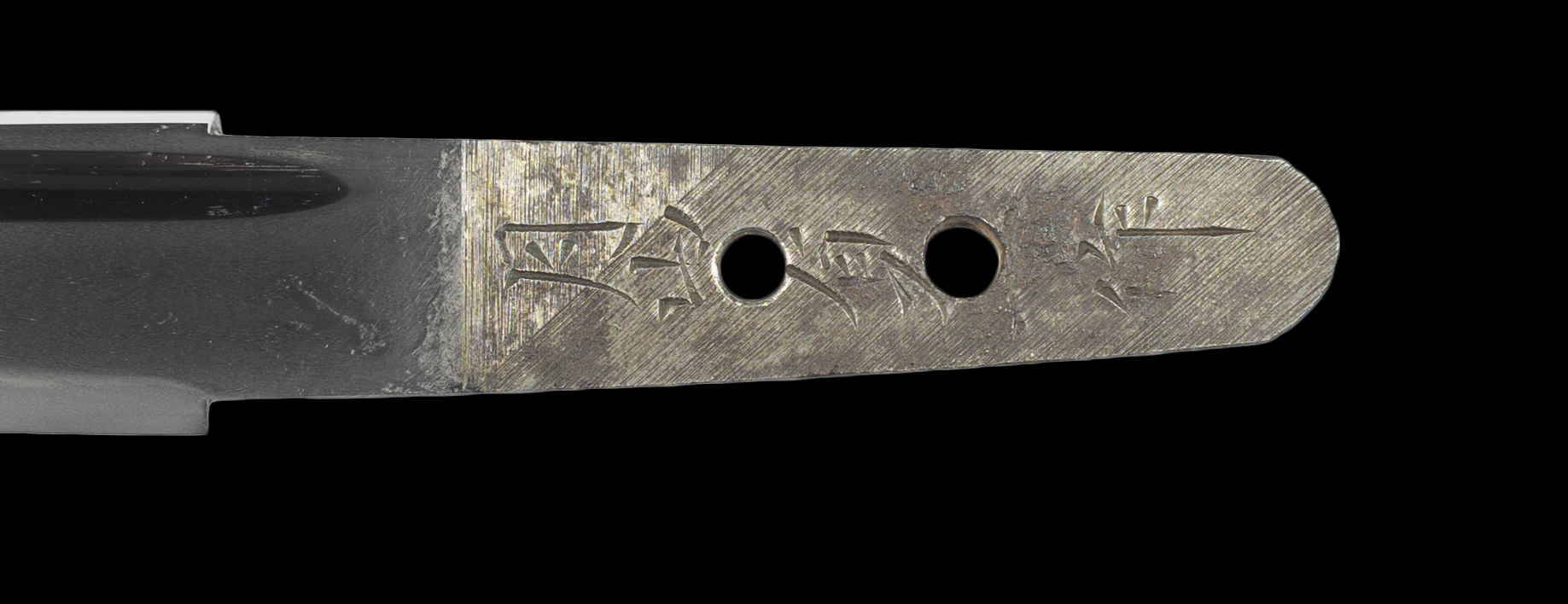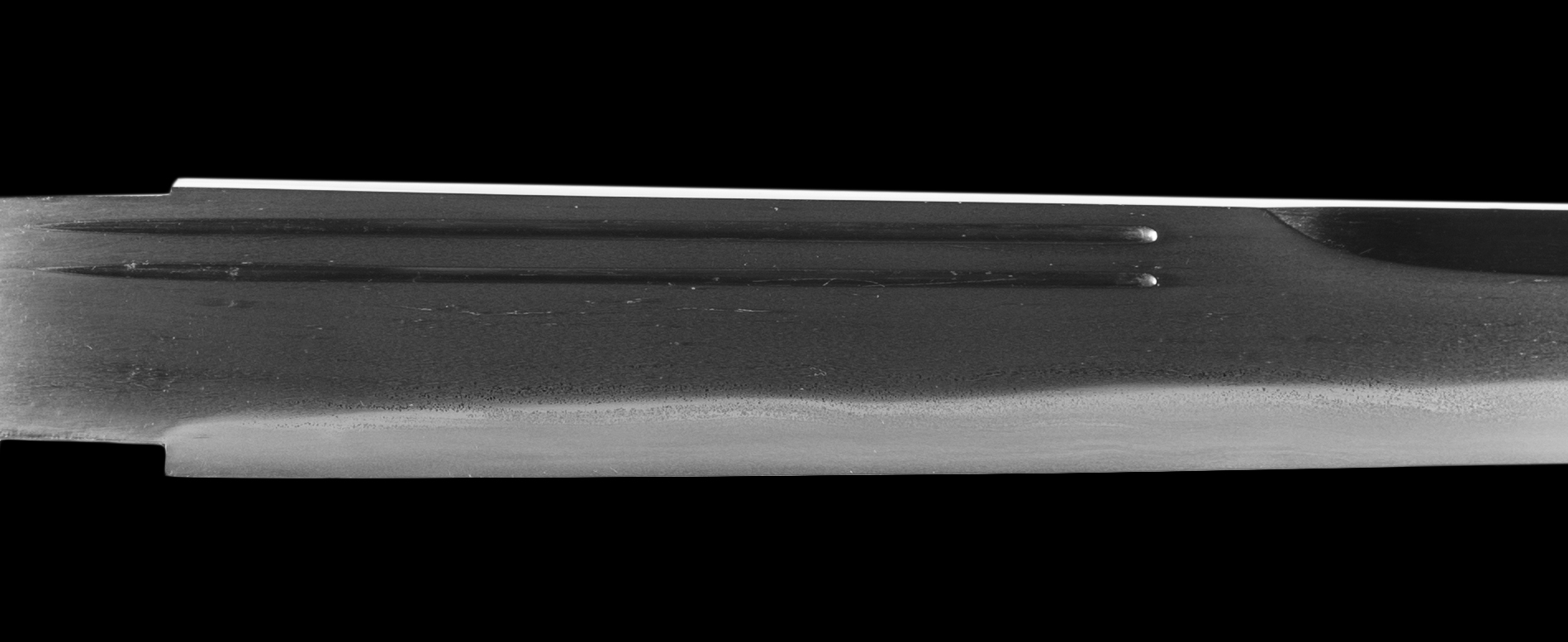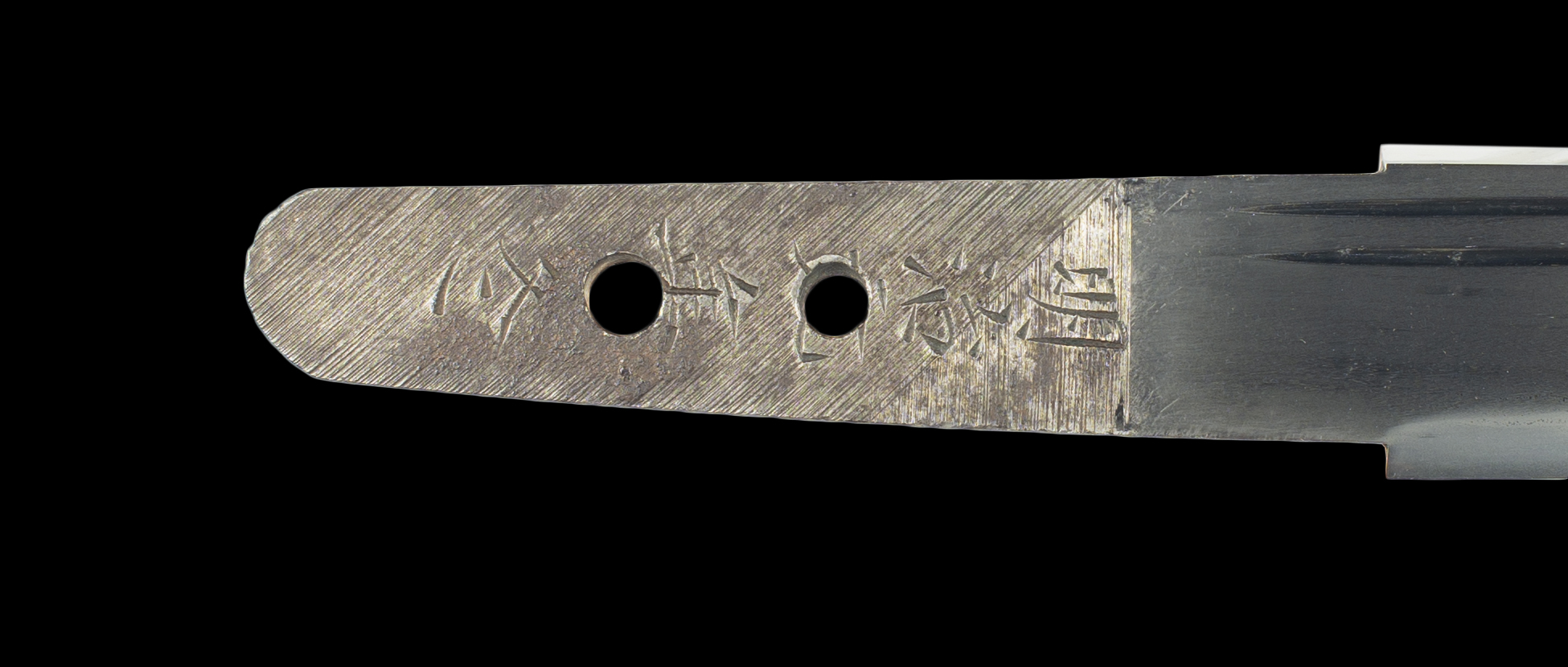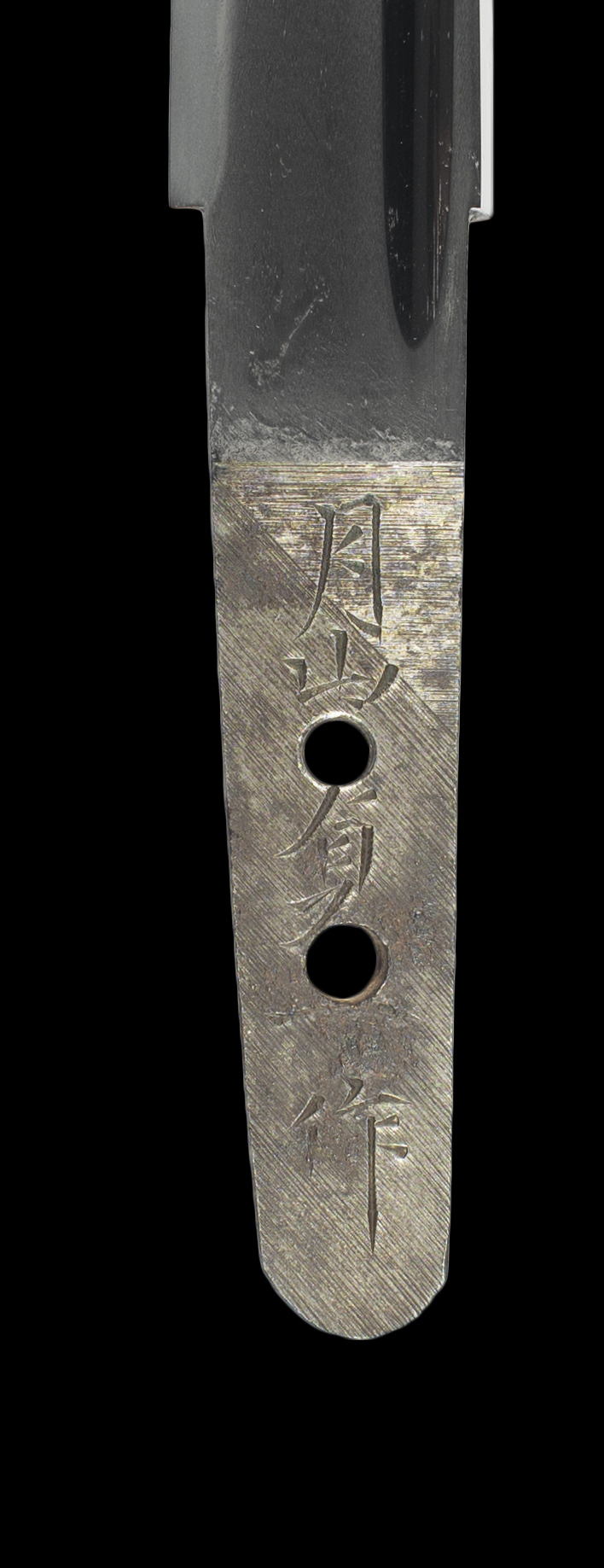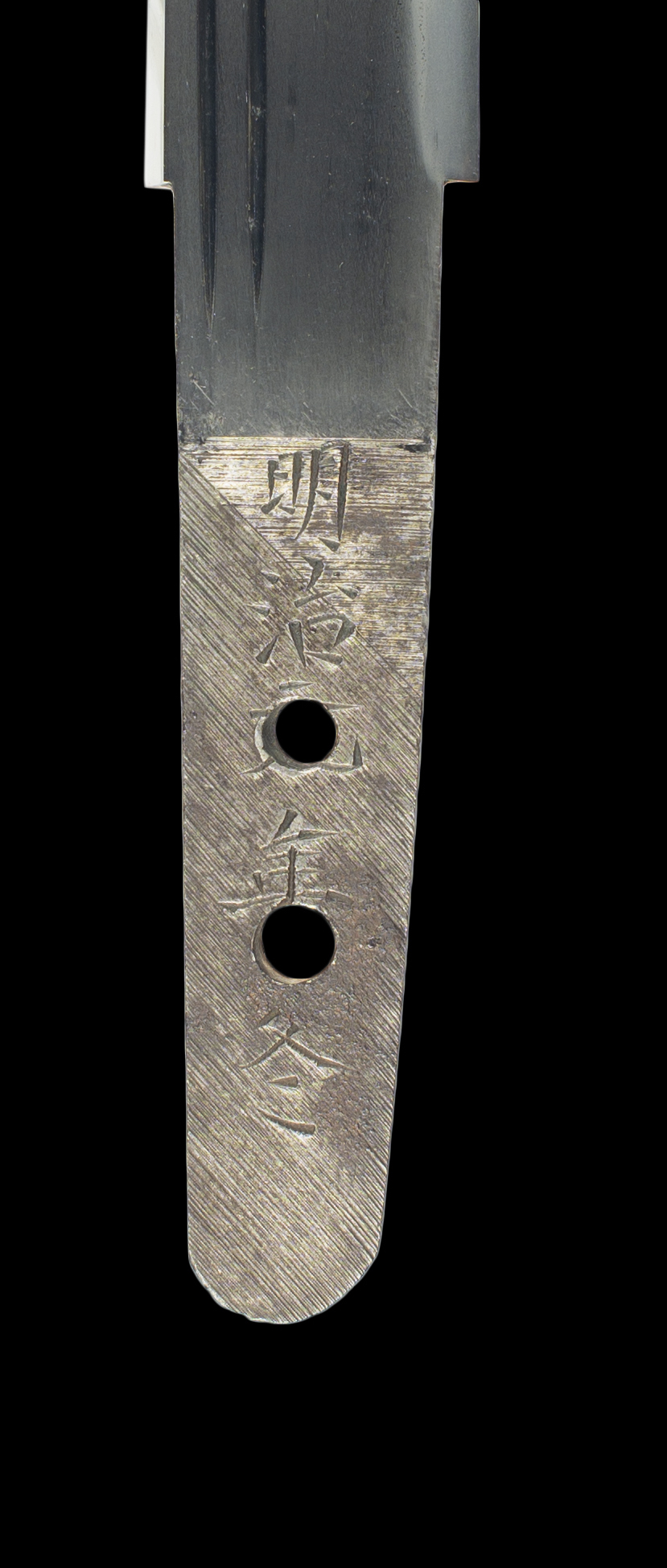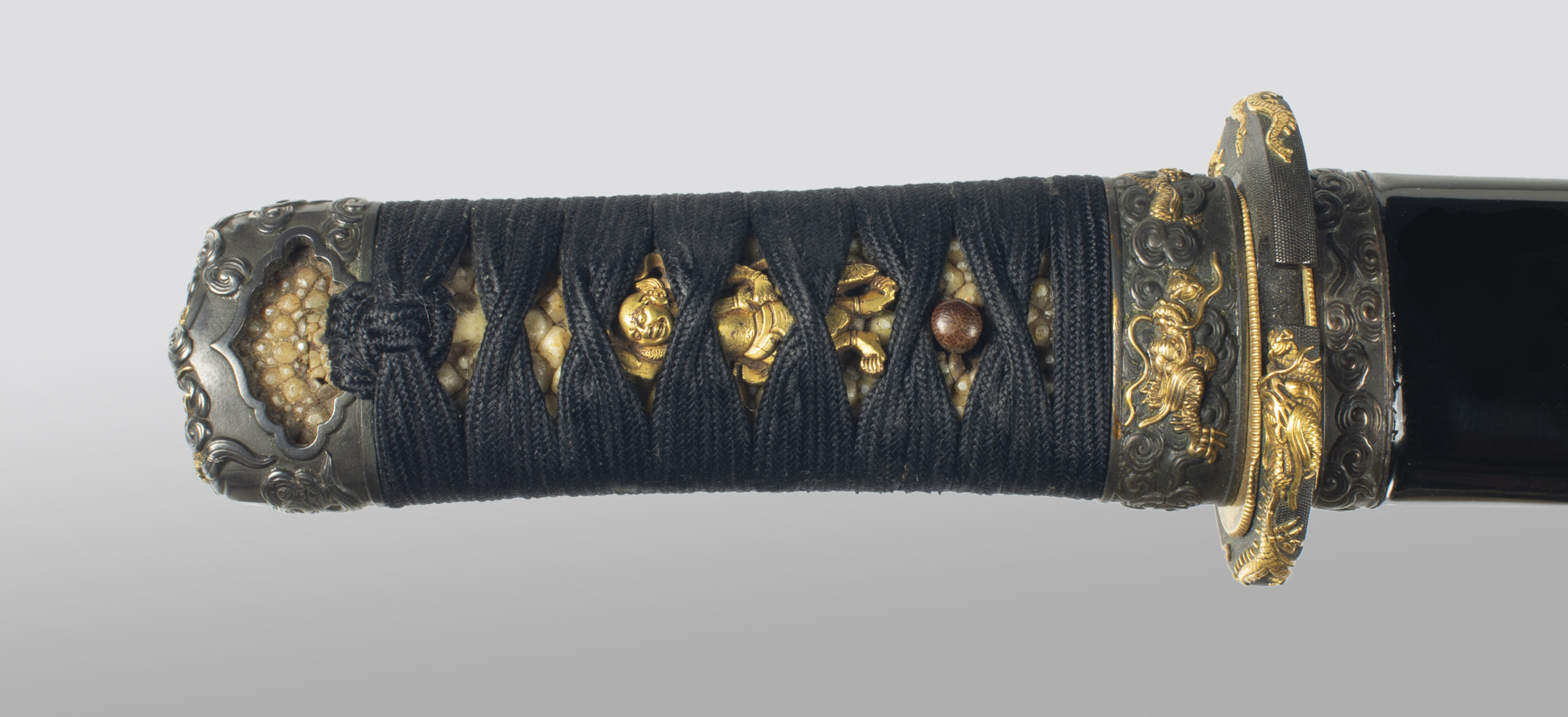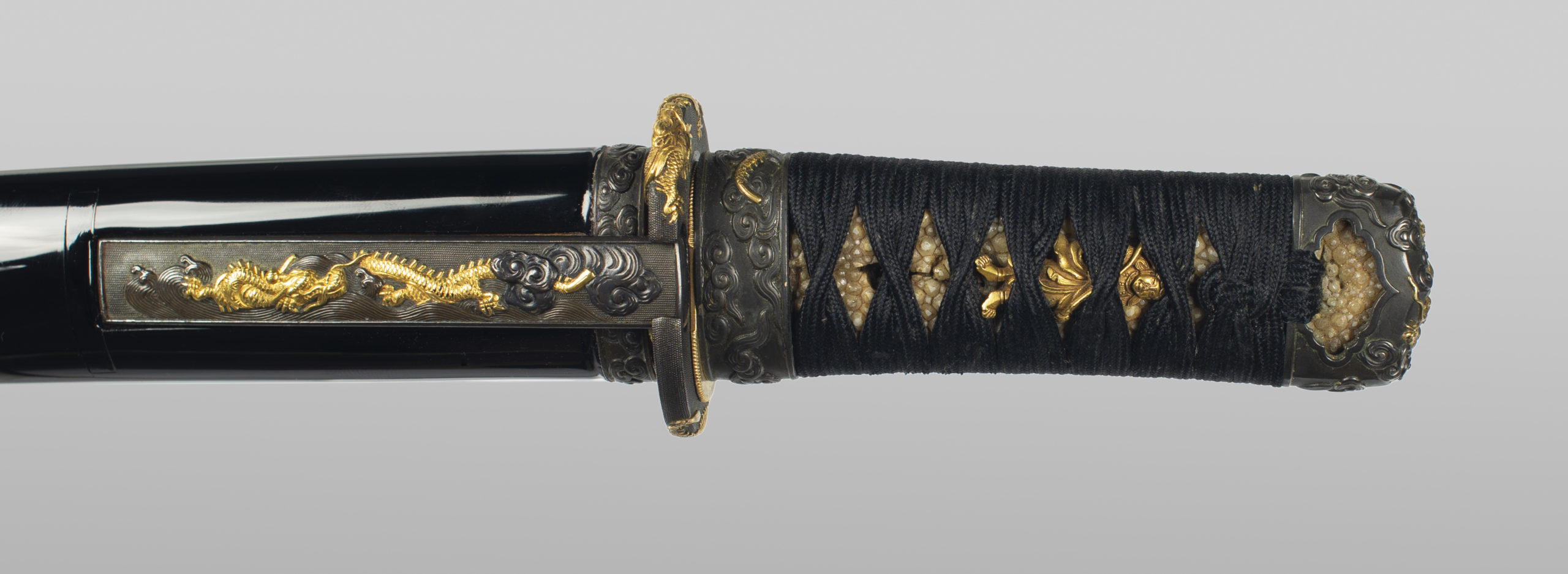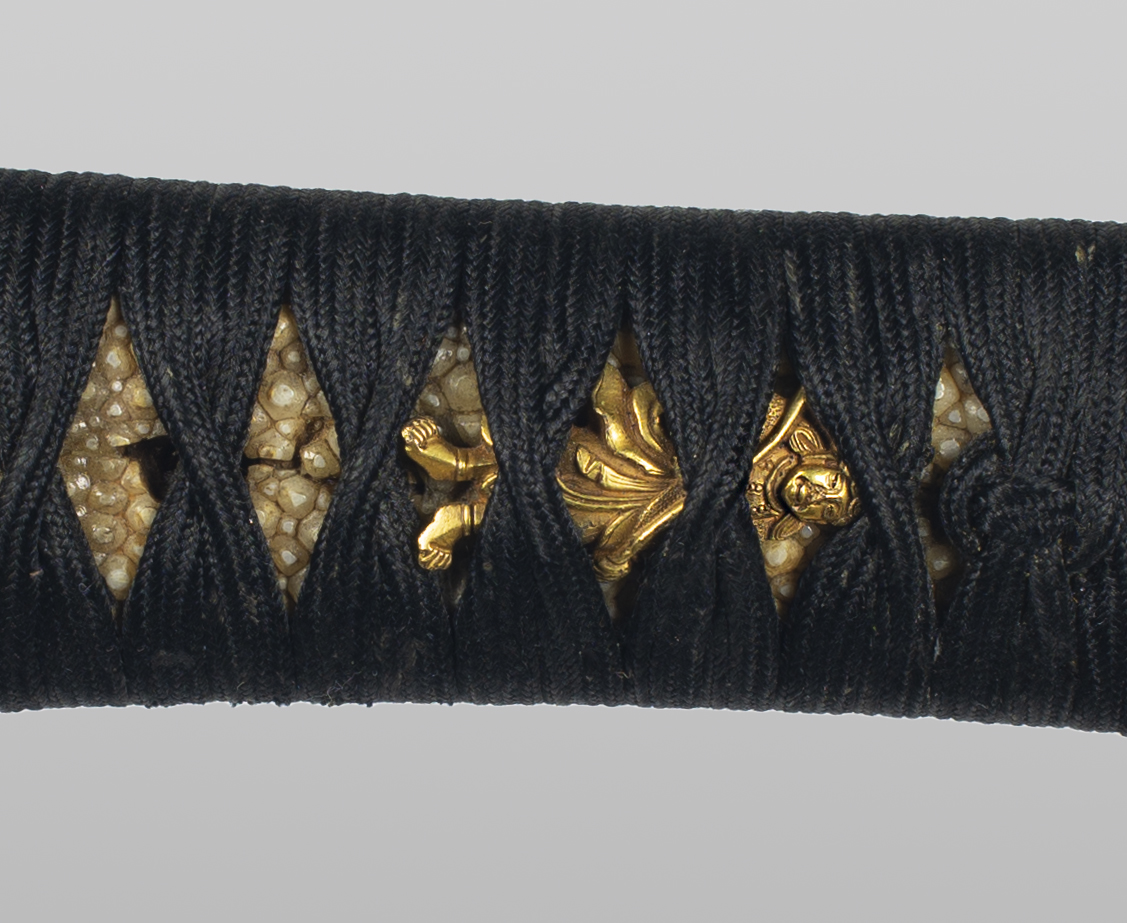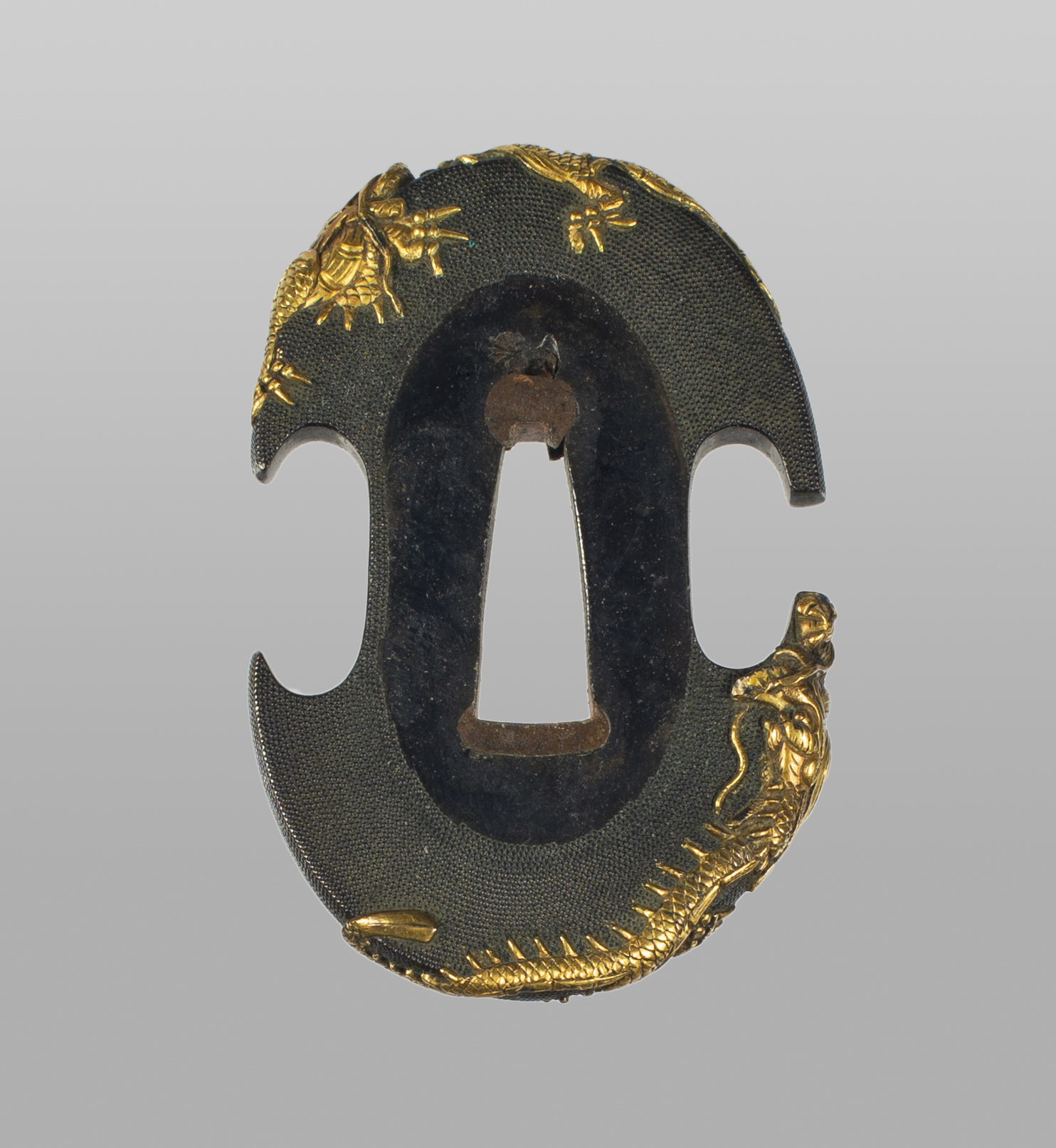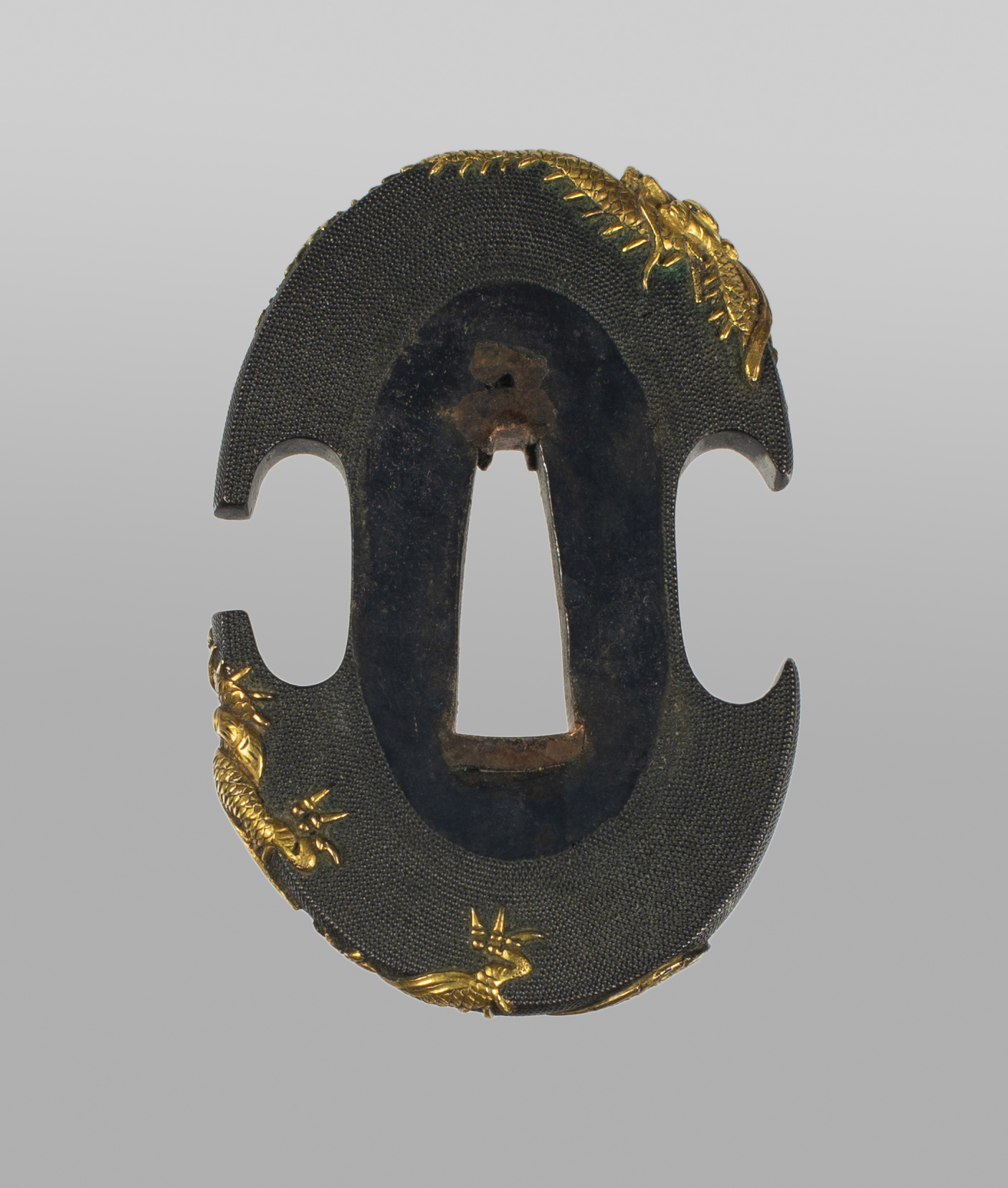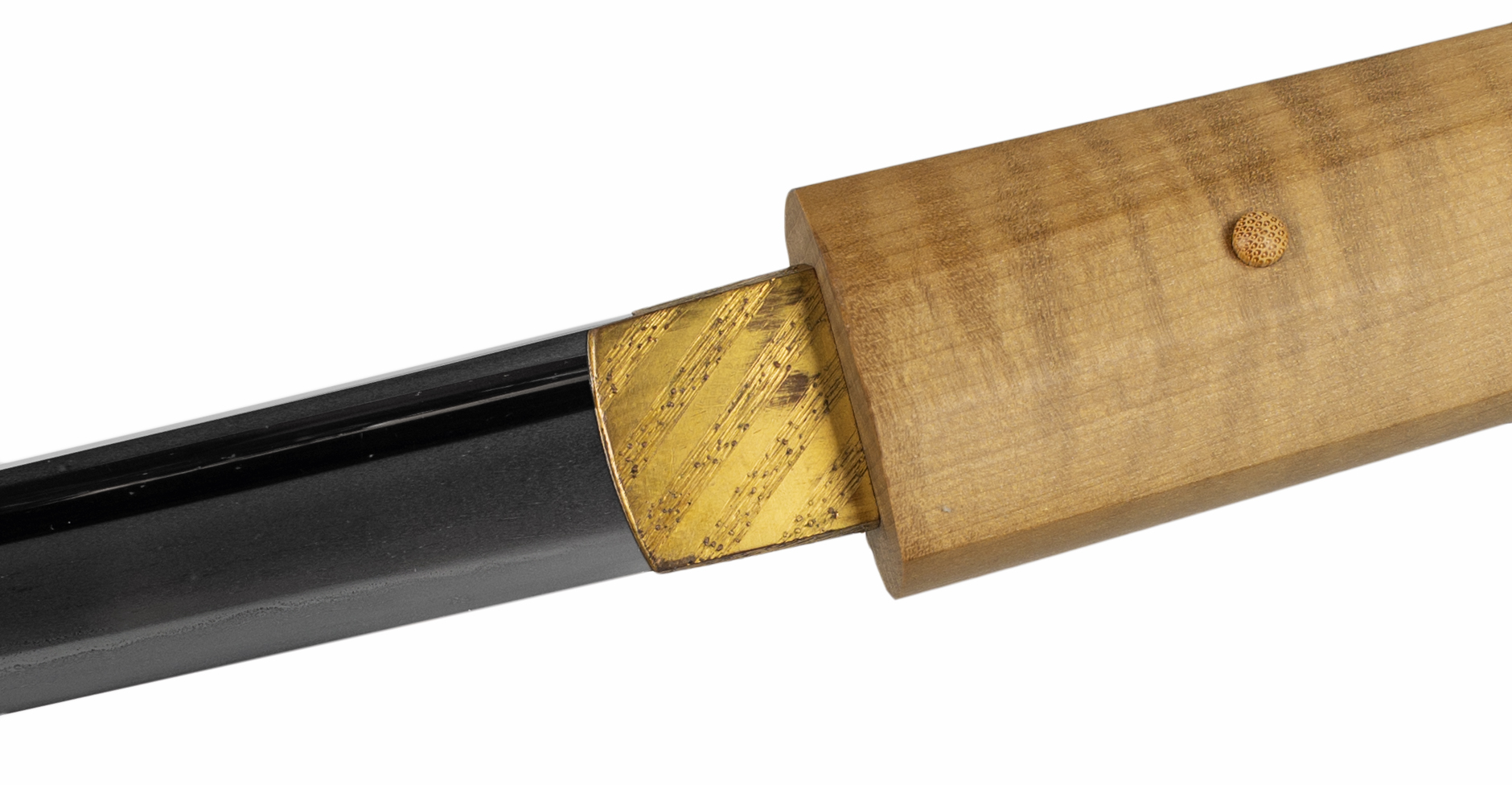Gallery Page (Display Only)
tanto by Gassan Sadakazu (1834-1918)
Meiji 1 – Winter 1868
w/Dragon fittings and kozuka by main-line 13th gen. Goto master
Swordsmith: Gassan Sadakazu (1834-1918)
Period: Meiji 1, 1868 (Winter)
Location: Settsu
Approx measurements: Nagasa (cutting edge length): 21.5 cm
Kitae: ko-itame
Hamon: suguha
Boshi: ko-maru
Horimono (engraving): Omote- Koshi-bi (a short type of groove
carved into the blade close to the tang), Ura- gomabashi (chopstick
grooves with claw underneath)
Nakago: two mekugi-ana
Yasurime: sujikai (slanted filing pattern) with distinctive start of filling marks on tanto
Signature: Gassan Sadakazu saku
Dated: Meiji gannen fuyu / Winter of Meiji 1 [1868]
Certificates: (3)
NBTHK Tokubetsu Hozon (a sword Extraordinarily Worthy of Conservation by the Society for the Preservation of the Japan Art Sword)
NTHK: Blade, NTHK-NPO: Koshirae Kanteisho (a sword/koshirae designated as Important by the Non-Profit Japanese Sword Appraisal Association)
Ratings:
Fujishiro’s reference: Jo Jo Saku (Above Superior made)
Koshirae: Older mounts with; Hilt covered with white same and wrapped hishimaki-style with black cords; fuchigashira of shibuichi, with gold iroe, depicting a cloud dragon; menukiof shakudō, in katachibori, with gold iroe, depicting Fudo-Myōō; hamidashi-tsuba of shakudō with a nanako ground depicting a creeping dragon; kozuka of shakudō with a nanako ground, with gold iroe, depicting waves and a cloud dragon, signed: “Mon Eijō Mitsutaka + kaō” (紋栄乗 光孝「花押」). Fittings were likely repurposed by Enjo Mitsutaka.
The kozuka is signed by the Goto mainline master, Enjo Mitsutaka. Mitsutaka was the 13th master of the prestigious Goto School and was also considered one of the best among all 17 mainline masters. He was also considered the best at attributing past works that were unsigned, and or repairing / remounting works of the older masters.
*2.13 Gotō Enjō (後藤延乗), 13th gen. information & chart: Courtesy – Markus Sesko (Author), E-Nihon-shinshintō-shi (page 63 & 68), Click to purchase
“Enjō, born in the sixth year of Kyōhō (1721), was the second son of Jujō but succeeded as the 13th head of the Gotō family because his older brother Kanjō (閑乗) – called „Mitsusuke“ (光佐), who died on the seventh day of the second month of Kansei ten (1798) – had to retire for health reasons. Before adopting the name „Shirōbei“ he was called „Gennojō“ ( 源之丞) and his civilian name was „Mitsunari“ (光成). Later, as head of the family, he changed this name to „Mitsutaka“ (光孝). Enjō died on the 18th day of the ninth month of Tenmei four (1784), at the age of 68. Around Enjō ́s time, the Gotō artists „broke with tradition“ and also made fuchigashira, other sword fittings, and an increasing number of tsuba, for example the shakudō-tsuba with nanako ground which had to be worn by bushi on certain occasions (banzashi-daishō).” See GOTO chart next pg.
Included: Koshirae, Shirasaya, carry bags
Note: In 1906 he was nominated as Teishitsu Gigei In ( 帝 室 技 芸 員 ) (Craftsman authorized by the Imperial court). This was a title equivalent to todays Living National Treasure.
NBTHK Tokubetsu Hozon certificate
TRANSLATION:
KANTEI-SHO (鑑定書) – APPRAISAL
No 147372
tantō, signed: Gassan Sadakazu (月山貞一)
Meiji gannen fuyu (明治元年冬, “winter of Meiji one [1868]”)
nagasa ~ 21.5 cm
According to the result of the shinsa committee of our society, we judge
this work as authentic and rank it as tokubetsu-hozon-tōken.
June 10, 2002
[Foundation] Nihon Bijutsu Tōken Hozon Kyōkai, NBTHK (日本美術刀劍保存
協會)
NTHK certificate
TRANSLATION:
Gassan Sadakazu (月山貞一)
shōshin (正真) – Authentic
nagasa 7sun 1 bu han kore ari (長さ七寸壱分半有之) – Blade length ~ 21.5 cm
Heisei 1 nen 10 gatsu 15 nichi (平成元年十月十五日) – October 15, 1989
Nihon Tōken Hozon Kai (日本刀剣保存会) – NTHK
No 10761
meibun (銘文) – Signature: Gassan Sadakazu saku (月山貞一作)
Meiji gannen fuyu (明治元年冬, “winter of Meiji one [1868]”)
kitae ( 鍛 ) – Forging: ko-itame hamon
(刃紋) – Hardening: suguha
bôshi (鋩子) – Hardening in tip: ko-maru
chôkoku (彫刻) – Engravings: on the omote side a koshibi, on the ura side
gomabashi
nakago (中心) – Tang: mekugi-ana (目釘穴) 2, yasurime (鑢): sujikai with
distinctive start of file marks
bikô (備考) – Remarks: Settsu Province
shinsa’in natsu’in (審査員捺印) – Seals of Judges: 2 seals
NTHK NPO KOSHIRAE CERTIFICATE
TRANSLATION:
Certificate # 275
koshirae
chiisagatana-koshirae with black glossy-lacquer saya and en suite fittings
Overall length 42.5 cm
Hilt covered with white same and wrapped hishimaki-style with black
cords; fuchigashira of shibuichi, with gold iroe, depicting a cloud dragon;
menuki of shakudō, in katachibori, with gold iroe, depicting Fudo- Myōō;
hamidashi-tsuba of shakudō with a nanako ground depicting a creeping
dragon; kozuka of shakudō with a nanako ground, with gold iroe,
depicting waves and a cloud dragon, signed: “Mon Eijō Mitsutaka + kaō”
( 紋栄乗 光孝「花押」)
Kantei remarks:
Late Edo period
77/100 points
NTHK-NPO shinsa work sheet
Page from John Scott Sloughs book –
“An Oshigata book of MODERN JAPANESE SWORDSMITHS 1868-1945”
meibun (銘文) – Signature: Gassan Sadakazu saku (月山 貞一作) Meiji gannen fuyu (明治元年冬, “winter of Meiji one [1868]”)
The Gassan school (月山)
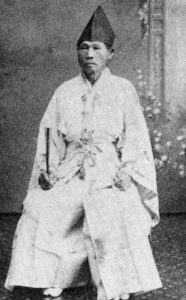 The time-honoured kotō Gassan school was taken-up again in the shinshintō times by Sadachika (貞近). Sadachika, his civilian name was „kuyama Yasaburō (奥山弥三郎), was born in Meiwa eight (明和, 1771) in Sasagawa (笹川) in the Nishimurayama district ( 西 村 山 郡 ) of Dewa province. It is said that he was a descendant of the Gassan lineage and he died on the 19th day of the fifth month of Kaei four (嘉永, 1851) at the age of 81. But the actual revival of the school has to be attributed to Sadachika´s son Gassan Yahachirō(月山弥八郎) who adopted the name „Gassan” as his family name and who signed „Sada-yoshi” ( 貞吉). Some old transmissions say that Sadayoshi was born in the first year of Tenmei ( 天 明 , 1781) and died on the 19th day of the second month of Meiji three (1870) at the age of 90. But in Tenmei one his father Sadachika was only ten years old and so another transmission is much more likely, namely that he died in 1870, not at the age of 90 but 71. This, in turn, calculates his year of birth as Kansei two ( 寛政, 1800). However, Sadayoshi left Dewa in the early years of the Bunsei era ( 文 政 , 1818-1830) and went to Edo to study under Suishinshi Masahide. After that, i.e. in Tenpōfour (天保, 1833), he moved to Ōsaka where he laid the foundation for the more recent success story of the Gassan school. We know blades from Sadayoshi from the Bunsei to the end of the Keiōera ( 慶 応 , 1865-1868). His jihada is the typical Gassan ayasugi, a masame in the Yamato tradition, or a dense mokume. The hamon is either a suguha in nie-deki, a small-dimensioned chōji-midare, or a koshi-no-hiraita midare. It is said that his adopted son Sadakazu made several daisaku-daimei works for him in his later years.
The time-honoured kotō Gassan school was taken-up again in the shinshintō times by Sadachika (貞近). Sadachika, his civilian name was „kuyama Yasaburō (奥山弥三郎), was born in Meiwa eight (明和, 1771) in Sasagawa (笹川) in the Nishimurayama district ( 西 村 山 郡 ) of Dewa province. It is said that he was a descendant of the Gassan lineage and he died on the 19th day of the fifth month of Kaei four (嘉永, 1851) at the age of 81. But the actual revival of the school has to be attributed to Sadachika´s son Gassan Yahachirō(月山弥八郎) who adopted the name „Gassan” as his family name and who signed „Sada-yoshi” ( 貞吉). Some old transmissions say that Sadayoshi was born in the first year of Tenmei ( 天 明 , 1781) and died on the 19th day of the second month of Meiji three (1870) at the age of 90. But in Tenmei one his father Sadachika was only ten years old and so another transmission is much more likely, namely that he died in 1870, not at the age of 90 but 71. This, in turn, calculates his year of birth as Kansei two ( 寛政, 1800). However, Sadayoshi left Dewa in the early years of the Bunsei era ( 文 政 , 1818-1830) and went to Edo to study under Suishinshi Masahide. After that, i.e. in Tenpōfour (天保, 1833), he moved to Ōsaka where he laid the foundation for the more recent success story of the Gassan school. We know blades from Sadayoshi from the Bunsei to the end of the Keiōera ( 慶 応 , 1865-1868). His jihada is the typical Gassan ayasugi, a masame in the Yamato tradition, or a dense mokume. The hamon is either a suguha in nie-deki, a small-dimensioned chōji-midare, or a koshi-no-hiraita midare. It is said that his adopted son Sadakazu made several daisaku-daimei works for him in his later years.
Sadakazu (貞一), who bore the civilian name „Gassan Yagorō (月山弥五郎), was born in the second month of Tenpō seven ( 天 保 , 1836) in the village of Sugoshi ( 須越) in the Inugami district (犬上) of Ōmi province. He was adopted by Sadayoshi at the age of seven. In Meiji 39 (明治, 1906) he was appointed teishitsu-gigei´in (帝室技芸員, lit. „ember of the Imperial Arts and Crafts”), the equivalent to the later title of Living National Treasure. He and Miyamoto Kanenori (宮本包則) were the only swordsmiths awarded with this honour. The teishitsu-gigei´in program was founded by the Meiji government in 1890 to preserve the traditional arts and crafts. – 125 –
Sadakazu´s gō were Kōkensai” (光顕斎), „nryūhi” (雲龍子) and „uiyūhi” (水勇 子 ). He died on July 11th 1918 at the age of 84 and we know from him dated blades from the third year of Kaei (嘉永, 1850) – he was only 15 years old at that time – to his year of death in 1918. That means he was active as swordsmith for about 70 years. He mastered all traditions and is regarded, besides Honjō Yoshitane (本荘義 胤) and Kurihara Nobuhide (栗原信秀), as the greatest horimono engraver of the shinshintō times. Some suggest Suishinshi Masahide as the founder and Gassan Sadakazu as the last great master of the shinshintō. Sadakazu also played an important role in passing-on the craft to the subsequent gendaitō swordsmiths. His blades have a rather long nagasa, a shallow sori, a widemihaba, and a chūor an ō-kissaki, i.e. altogether a magnificent and grand shape, but he also made some blades with a sugata in the style of the early Muromachi period. Incidentally, blades made in the Keiōera ( 慶 応 , 1865- 1868) are especially impressive. He also made many copies of kotō works and worked for the military after the sword ban where more slender and shorter blades were needed. He forged the traditional ayasugi-hada of the Gassan school, a masame in the Yamato tradition, a mokume, a kokume and also an itame. According to the tradition he worked in, he tempered an elaborate chōjimidare in nioi-deki with a narrow yakihaba and long ashi in the style of the Ōei- Bizen school (応永備前), a ko-chōji-midare in ko-nie-deki, a chū-suguhahotsure in the style of the Yamashiro tradition, or a gunome-midare with thick nie and nioi and plenty of hataraki in the style of the Sōshū tradition. The bōshi shows a roundish kaeri or runs out as yakitsume. He applied many different horimono like dragons, dragon and plum branches, kenmaki-ryū, waterfalls, Fudō-Myōō, bonji and the like. All of them are finely engraved and some remind us of carvings by Ikkanshi Tadatsuna (一竿子忠綱). Sadakazu´s blades show a long and carefully finished tang with a kurijiri and sujikai- yasurime with keshōwhereas each file stroke is exactly applied. During the Keiōand Meiji era he added a characteristic koku´in (see picture 90), and in the fifth year of Taishō (1916) he forged a tachi on the occasion of the enthronement of emperor Yoshihito (嘉仁, 1879-1926).
*Gassan School information: Courtesy – Markus Sesko (Author), ENihon-shinshintō-shi (pages 124-125), Click to purchase
This Sword is not available for purchase.
If you wish to purchase a Japanese Sword please view our Nihonto for sale page or contact us directly via email or contact us at 1(608) 315-0083 any time, please include specifics of what you seek, i.e.: Katana, maker, era, price range etc.
Pictures and content may not be copied without the express permission of samuraisword.com ©






